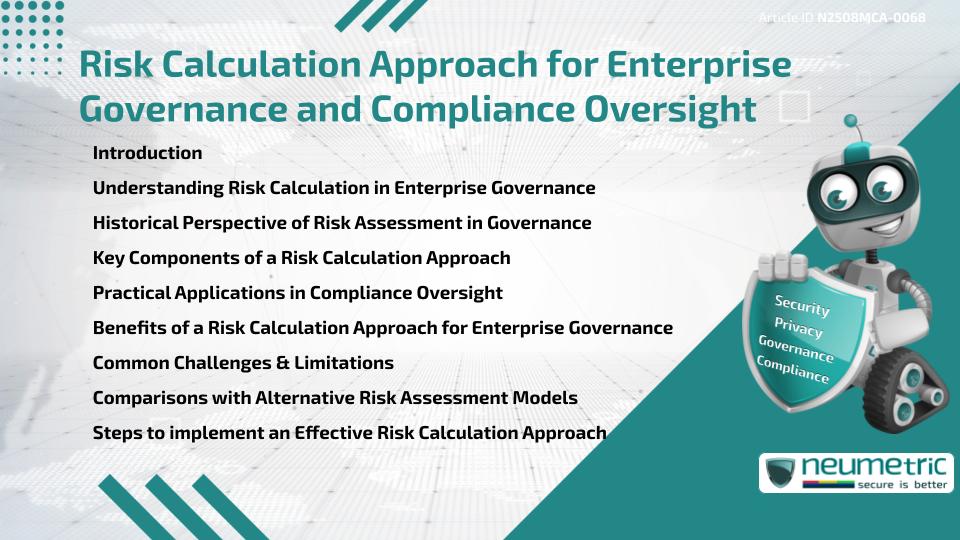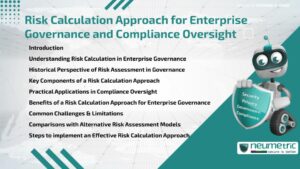Table of Contents
ToggleIntroduction
A Risk calculation approach for enterprise Governance provides Organisations with a systematic method to measure, analyse & manage potential Risks that can impact compliance & decision-making. By using structured calculations, enterprises ensure that Governance processes are not only transparent but also rooted in measurable outcomes. This approach enables leaders to balance opportunities with Threats, maintain regulatory alignment & reduce the Likelihood of costly failures. In compliance oversight, applying Risk calculations enhances accountability, supports audits & fosters long-term trust with Stakeholders.
Understanding Risk Calculation in Enterprise Governance
Enterprise Governance requires a clear understanding of how Risks can affect operations, finances & reputation. The Risk calculation approach for enterprise Governance focuses on quantifying Risks using both qualitative & quantitative methods. For example, probability & impact assessments help decision-makers weigh the significance of a Risk. Much like using a scale to measure weight, these calculations allow Organisations to assign tangible values to otherwise uncertain outcomes.
Historical Perspective of Risk Assessment in Governance
Risk Assessment has been part of Governance since ancient times when leaders made judgments about war, trade & resource allocation. Over time, Organisations adopted more structured methods such as actuarial tables in insurance & Financial models in banking. With increasing global regulations, Governance today relies heavily on structured frameworks like the COSO Framework & ISO 31000 to integrate Risk calculations into compliance oversight. This historical evolution shows that while tools have changed, the fundamental need to measure & balance Risk has remained constant.
Key Components of a Risk Calculation Approach
Several components form the foundation of an effective Risk calculation approach for enterprise Governance:
- Risk Identification: Pinpointing areas of Vulnerability.
- Probability Estimation: Assessing how likely an event is to occur.
- Impact Analysis: Determining the potential effect on operations.
- Risk Scoring: Combining probability & impact into measurable scores.
- Prioritisation: Ranking Risks to focus on those with the greatest impact.
Together, these components provide a structured way for Organisations to align their compliance oversight with Governance objectives.
Practical Applications in Compliance Oversight
Compliance oversight requires Organisations to demonstrate that they follow regulations, standards & ethical practices. A Risk calculation approach for enterprise Governance ensures oversight is not reactive but proactive. For instance, Financial institutions use Risk scoring to identify suspicious transactions, while Healthcare Organisations apply calculations to monitor Patient Data Security. By embedding Risk calculation into oversight, enterprises strengthen their ability to comply with regulations such as GDPR, HIPAA & SOX.
Benefits of a Risk Calculation Approach for Enterprise Governance
The use of a Risk calculation approach brings several benefits:
- Enhances transparency in Governance decisions.
- Improves compliance monitoring.
- Allows efficient resource allocation.
- Strengthens resilience against operational disruptions.
- Builds Stakeholder confidence by showing Evidence-based oversight.
In essence, it helps Organisations strike a balance between achieving goals & minimizing Threats.
Common Challenges & Limitations
Despite its advantages, a Risk calculation approach has challenges. Quantitative models may oversimplify complex Risks, while qualitative methods can be subjective. Data availability & accuracy also limit effective calculations. Additionally, overreliance on numerical scores may cause Organisations to overlook emerging Risks that lack sufficient historical data. These limitations highlight the need to combine calculation methods with expert judgment.
Comparisons with Alternative Risk Assessment Models
Unlike scenario analysis or Risk mapping, the Risk calculation approach for enterprise Governance emphasises measurable outcomes. Scenario analysis explores hypothetical situations, while Risk mapping visualises Risks across categories. Calculation, on the other hand, provides tangible scores that can be compared & tracked over time. This makes it particularly useful for compliance oversight where regulators & Auditors require documented, measurable Evidence.
Steps to implement an Effective Risk Calculation Approach
Implementing a Risk calculation approach requires careful planning:
- Define Governance & compliance objectives.
- Identify relevant Risks through assessments & audits.
- Collect accurate data to support probability & impact analysis.
- Apply calculation models consistently across departments.
- Review & adjust Risk scores based on changing environments.
- Integrate the results into Governance Policies & compliance programs.
This structured process ensures that the approach becomes a continuous cycle rather than a one-time exercise.
Conclusion
A Risk calculation approach for enterprise Governance is a cornerstone of effective compliance oversight. It ensures that Organisations quantify Risks, align Governance with measurable results & maintain resilience in an ever-changing environment. By combining data-driven methods with expert insights, enterprises strengthen trust, accountability & operational efficiency.
Takeaways
- Risk calculation strengthens Governance by quantifying uncertainties.
- Compliance oversight becomes more transparent & Evidence-based.
- Historical & modern practices highlight its ongoing relevance.
- Challenges exist but can be managed with balanced methods.
- Implementation requires structured steps & Continuous Improvement.
FAQ
What is a Risk calculation approach for enterprise Governance?
It is a structured method of quantifying Risks to support Governance & compliance oversight.
How does Risk calculation support compliance oversight?
It provides measurable data to demonstrate compliance with laws & standards, making oversight more transparent & accountable.
What are the main components of a Risk calculation approach?
Key components include Risk identification, probability estimation, impact analysis, scoring & prioritisation.
Why is a historical perspective important in Risk Assessment?
It shows how Risk Management evolved from intuitive judgments to structured models, guiding modern Governance practices.
What are the limitations of relying solely on Risk calculation?
Limitations include data inaccuracy, subjectivity in assessments & the Risk of overlooking emerging Threats.
How is Risk calculation different from Risk mapping?
Risk calculation provides measurable scores, while Risk mapping visually represents categories of Risks without quantification.
Can small enterprises use a Risk calculation approach for enterprise Governance?
Yes, even smaller Organisations can benefit from structured Risk scoring to ensure compliance & resource efficiency
Need help for Security, Privacy, Governance & VAPT?
Neumetric provides organisations the necessary help to achieve their Cybersecurity, Compliance, Governance, Privacy, Certifications & Pentesting needs.
Organisations & Businesses, specifically those which provide SaaS & AI Solutions in the Fintech, BFSI & other regulated sectors, usually need a Cybersecurity Partner for meeting & maintaining the ongoing Security & Privacy needs & requirements of their Enterprise Clients & Privacy conscious Customers.
SOC 2, ISO 27001, ISO 42001, NIST, HIPAA, HECVAT, EU GDPR are some of the Frameworks that are served by Fusion – a SaaS, multimodular, multitenant, centralised, automated, Cybersecurity & Compliance Management system.
Neumetric also provides Expert Services for technical security which covers VAPT for Web Applications, APIs, iOS & Android Mobile Apps, Security Testing for AWS & other Cloud Environments & Cloud Infrastructure & other similar scopes. Reach out to us by Email or filling out the Contact Form…





